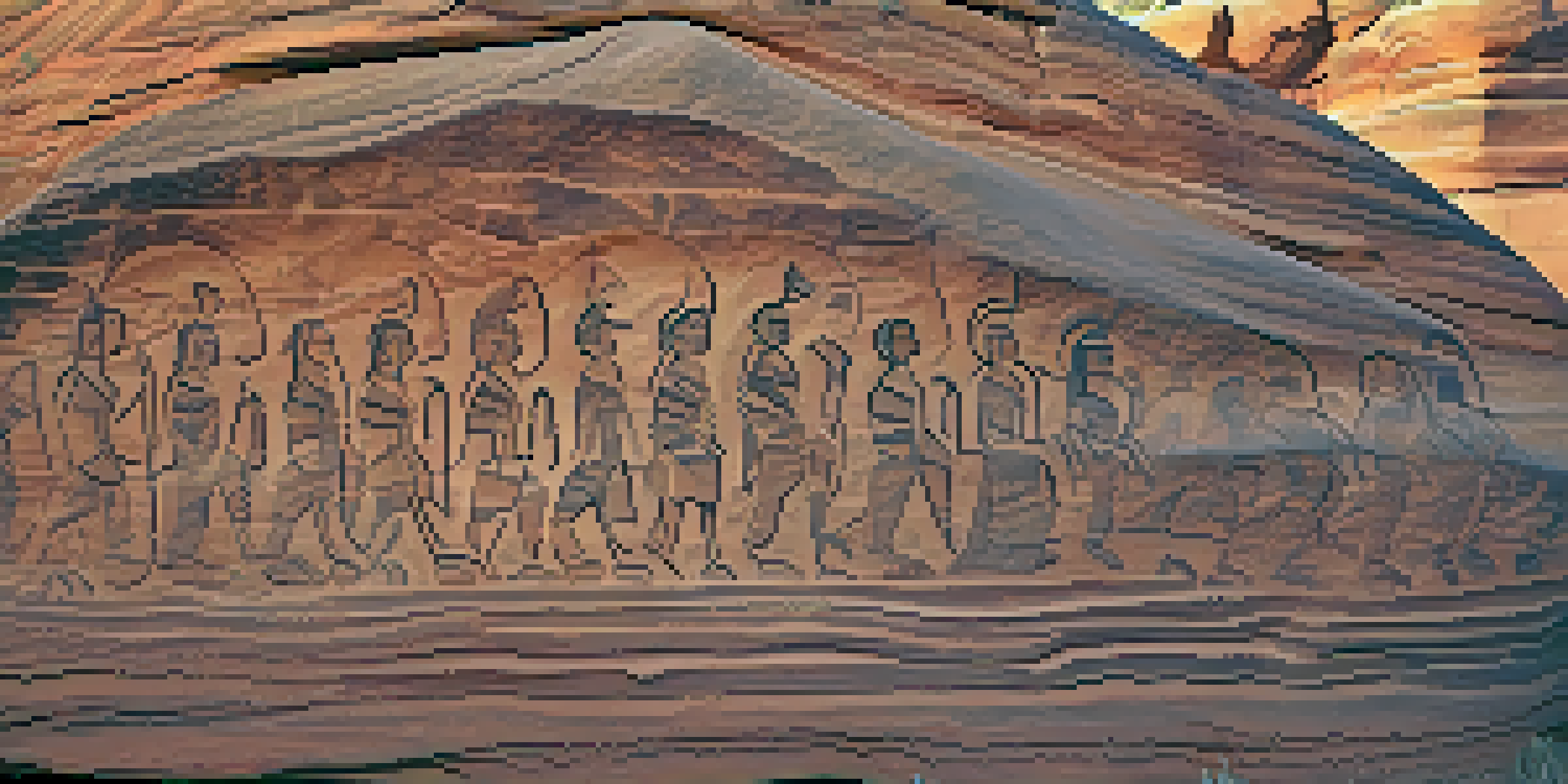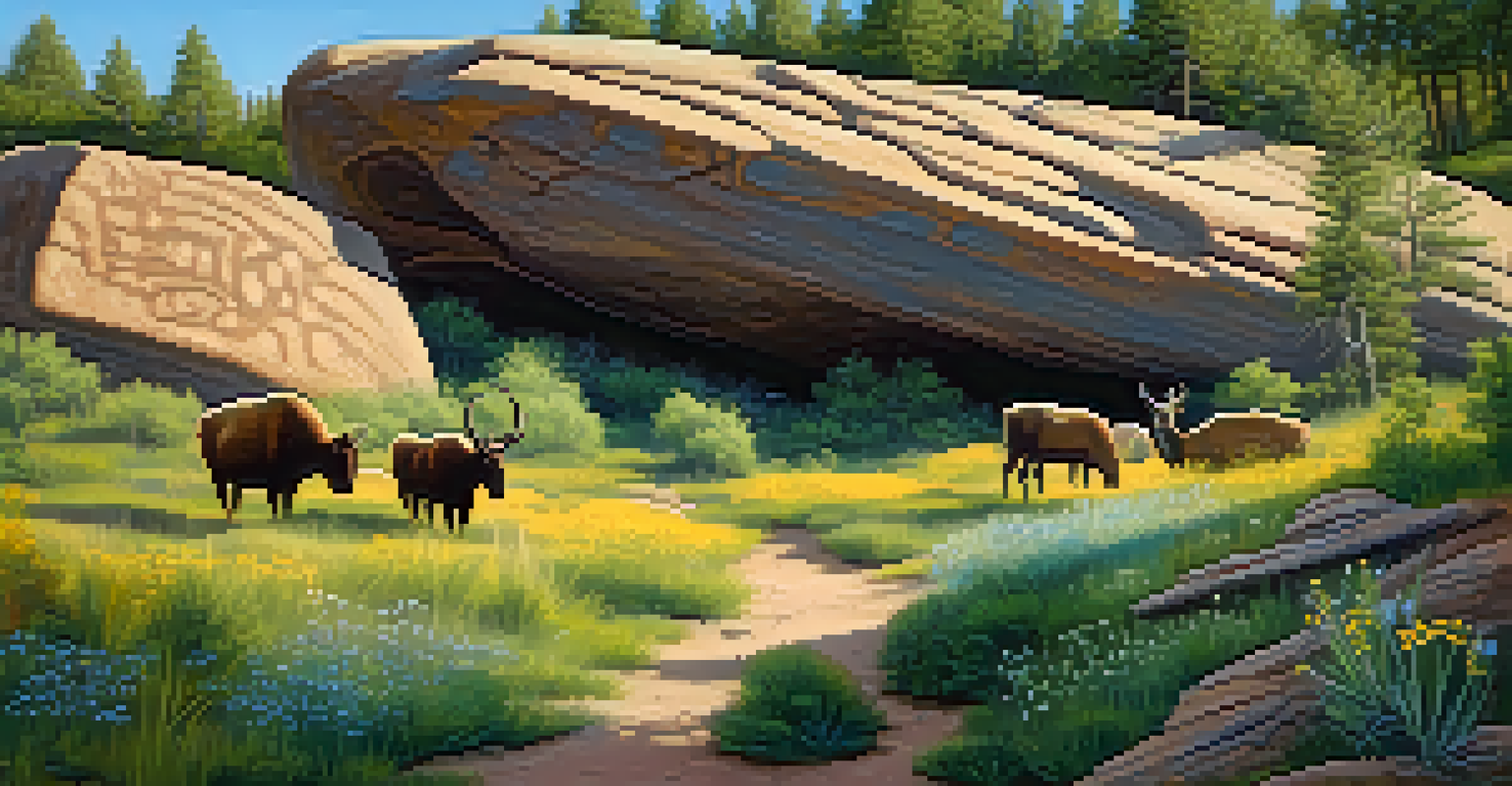Ancient Rock Art: Colorado's Ute Indian Petroglyphs

Introduction to Ute Indian Petroglyphs in Colorado
The Ute Indian petroglyphs of Colorado are more than just ancient carvings; they offer a glimpse into the rich cultural history of the Ute people. These intricate rock art pieces, found throughout Colorado's beautiful landscapes, depict a variety of symbols and figures that tell stories of daily life and spiritual beliefs. Walking among these petroglyphs is like stepping back in time, where each mark on the rock serves as a silent witness to the past.
The past is never dead. It's not even past.
Petroglyphs are images created by carving into rock surfaces, and in Colorado, they can be traced back thousands of years. The Ute tribes, known for their deep connection to nature, used these illustrations to communicate their experiences and values. Each petroglyph is unique, showcasing the creativity and skill of the artists who crafted them.
Understanding these petroglyphs requires a blend of history and interpretation. They reflect not just the artistic expressions of the Ute people, but also their relationship with the land, animals, and each other. This rich tapestry of meaning invites exploration and appreciation from those who seek to learn more.
The Historical Significance of Ute Petroglyphs
Ute petroglyphs play a critical role in understanding the historical context of the region. These rock carvings date back to a time when the Ute people roamed the Colorado mountains, hunting and gathering in harmony with nature. The images often depict animals, human figures, and symbols that represent their spiritual beliefs, showcasing their connection to the earth.

For the Ute tribe, these petroglyphs are not merely art; they are historical documents that offer insights into their way of life. By studying them, researchers can piece together how the Ute people interacted with their environment and each other, revealing a complex society rich in tradition and culture. This history is vital for appreciating the resilience and adaptability of indigenous peoples.
Cultural Heritage of Ute Petroglyphs
The Ute Indian petroglyphs are vital expressions of the Ute people's rich cultural history, showcasing their beliefs, experiences, and connection to nature.
Moreover, these petroglyphs serve as a bridge to understanding the ongoing cultural legacy of the Ute. They remind us that the history of Colorado is not only about settlers and pioneers but also about the original inhabitants who shaped the land long before. This perspective enriches our knowledge of the region and fosters a deeper respect for its history.
Styles and Techniques of Ute Rock Art
The Ute petroglyphs exhibit diverse styles and techniques that vary across different regions of Colorado. Carved into sandstone and granite, these images reflect the unique artistic expressions of the Ute people. Some petroglyphs are simple and abstract, while others are detailed and complex, showcasing the skill and creativity of the artists.
Art isn’t a thing; it’s a way.
One common technique used by the Ute was pecking, which involved striking the rock surface with a harder material to create images. This method allowed for a variety of designs, from geometric patterns to intricate representations of animals and people. The choice of imagery often held significant meaning, symbolizing everything from hunting success to spiritual beliefs.
These artistic expressions not only serve aesthetic purposes but also carry deep cultural significance. They embody the values, stories, and experiences of the Ute people, making them essential components of their heritage. By examining these styles and techniques, we gain a greater appreciation for the Ute's artistic legacy and the messages they intended to convey.
Key Locations to View Ute Petroglyphs
If you're eager to see Ute Indian petroglyphs in person, there are several incredible locations across Colorado that showcase these ancient artworks. One of the most notable sites is the Canyons of the Ancients National Monument, where visitors can find numerous rock art panels. This area offers a stunning backdrop of canyons and mesas, making it an ideal spot for both exploration and contemplation.
Another remarkable location is the Mesa Verde National Park, known for its cliff dwellings and rich archaeological history. Here, you can find petroglyphs that provide insight into the lives of the Ute and their ancestors. The park's guided tours often include discussions about the significance of these rock art pieces, enhancing your understanding of their cultural context.
Preservation Efforts Are Crucial
Preserving Ute petroglyphs is essential to protect their cultural significance and ensure that future generations can appreciate these ancient artworks.
Visiting these sites not only allows you to witness the petroglyphs firsthand but also encourages a deeper connection with the land and its history. It's a chance to appreciate the artistry and meaning behind each carving while respecting the traditions of the Ute people. This immersive experience fosters a greater appreciation for the cultural heritage of Colorado.
Interpreting Ute Petroglyphs: A Cultural Lens
Interpreting Ute petroglyphs requires understanding the cultural context in which they were created. Each symbol and figure conveys specific meanings that are rooted in the Ute's beliefs, experiences, and environment. For example, images of animals might represent important hunting practices, while human figures could illustrate social gatherings or spiritual rituals.
Cultural interpretations can vary, making it crucial to approach these petroglyphs with respect and a willingness to learn. Engaging with Ute descendants or cultural experts can provide valuable insights into the symbolism and significance of the artwork. This collaboration fosters a deeper appreciation for the heritage and ongoing traditions of the Ute people.
Moreover, interpreting these petroglyphs is not just about understanding the past; it also informs contemporary conversations about indigenous rights and cultural preservation. By recognizing the stories behind the art, we acknowledge the resilience of the Ute community and their continued connection to their ancestral lands. This awareness is vital for fostering mutual respect and understanding among all who share this beautiful region.
The Role of Preservation in Protecting Ute Rock Art
Preserving Ute petroglyphs is essential for maintaining the cultural heritage of the Ute people and the history of Colorado. As natural elements and human activities pose threats to these ancient artworks, conservation efforts have become increasingly important. Organizations and local tribes are working together to protect these significant sites for future generations.
One of the biggest challenges in preservation is balancing public access with the need to safeguard the petroglyphs from vandalism and environmental damage. Educational programs that raise awareness about the importance of these sites can help foster a sense of stewardship among visitors. By understanding the cultural significance of the petroglyphs, we can encourage respectful behavior toward these fragile artworks.
Art as Historical Insight
The petroglyphs serve as historical documents that reveal the Ute people's way of life, providing valuable insights into their interactions with the environment and each other.
Additionally, technology plays a growing role in preservation efforts. Using tools such as 3D scanning and photogrammetry, researchers can create digital records of the petroglyphs, ensuring that even if the originals suffer from erosion or damage, their history remains intact. This blend of traditional conservation methods and modern technology offers hope for the continued protection of Ute rock art.
Conclusion: Embracing the Legacy of Ute Petroglyphs
The Ute Indian petroglyphs of Colorado are more than ancient carvings; they are a testament to the enduring legacy of the Ute people. By exploring these artworks, we gain insight into their cultural heritage, beliefs, and history. Each petroglyph serves as a reminder of the deep connection between the Ute and their land, inviting us to reflect on our own relationships with nature.
As we appreciate these remarkable pieces of rock art, it's essential to honor the stories they tell and the people who created them. Engaging with the Ute community and supporting preservation efforts can help ensure that these cultural treasures are protected for future generations. By doing so, we contribute to a broader understanding of indigenous history and the rich tapestry of human experience.

In conclusion, the Ute petroglyphs are not just relics of the past; they are living symbols of culture, resilience, and connection. Let us embrace their legacy, celebrate their artistry, and commit to preserving their stories for those who will walk this land long after us.